Whale Watching Big Island: Top Spots & Tours for 2025
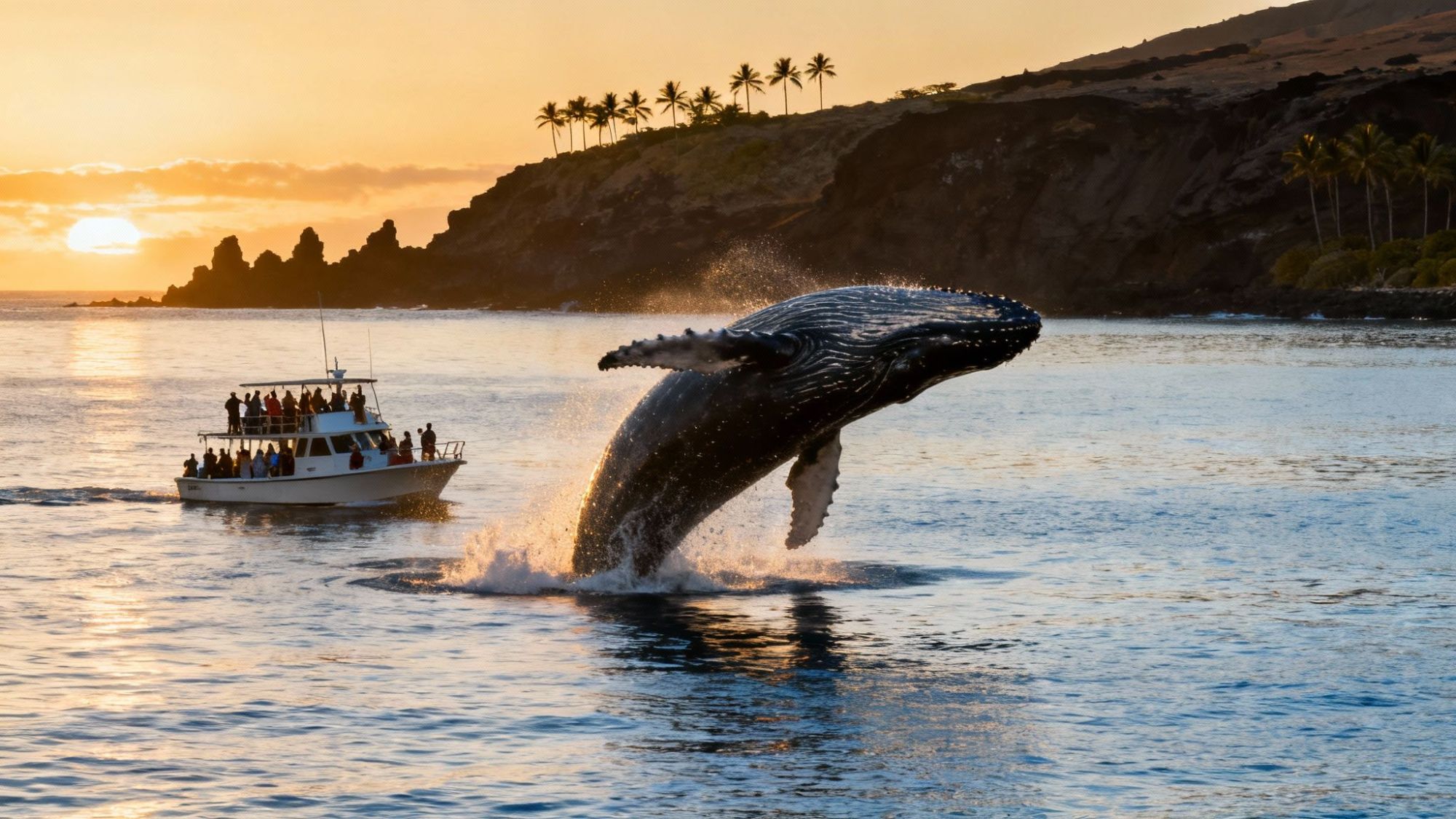
Welcome to the definitive guide for experiencing the magic of whale watching on the Big Island. Each year, from December through April, the warm, sheltered waters surrounding Hawaii's largest island become the stage for one of nature's most spectacular events: the annual migration of humpback whales. These gentle giants travel thousands of miles from their feeding grounds in Alaska to breed, give birth, and nurture their newborn calves in this protected marine environment.
This comprehensive listicle is designed to be your ultimate resource, whether you're planning to watch from the stunning volcanic shores or join an expert-led boat tour. We will provide a detailed breakdown of the premier locations, from the calm Kohala Coast to the dramatic cliffs of the Hilo side, and offer in-depth details on the most reputable tours available. This guide moves beyond simple lists, giving you practical insights into the best times to go, what makes each location unique, and how to select the right tour for your group.
Kona Snorkel Trips, as the top rated & most reviewed snorkel company in Hawaii, is passionate about connecting people with the incredible marine life here. We've compiled this resource to ensure your whale watching adventure is safe, respectful, and nothing short of breathtaking.
In this article, we will cover everything you need to know about whale watching Big Island experiences. You will learn about:
- Prime viewing seasons and the best times of day to spot activity.
- Top-rated boat tours and how to choose one that fits your budget and preferences.
- Excellent shore-based viewing spots for those who prefer to stay on land.
- Essential preparation tips, including what to bring for a comfortable and memorable trip.
- Conservation guidelines to ensure a safe and responsible encounter for both you and the whales.
1. Kohala Coast – Prime Humpback Whale Habitat
The Kohala Coast, stretching along the northwestern shore of the Big Island, is arguably the epicenter of whale watching on the Big Island. This area is renowned for its calm, clear, and protected waters, creating an ideal sanctuary for humpback whales. From December through April, these majestic animals migrate from their feeding grounds in Alaska to the warm Hawaiian waters to breed, give birth, and nurse their newborn calves, making the Kohala Coast a premier destination for witnessing these activities.
The unique geography of this coastline, sheltered from the stronger winds and swells by the island's massive volcanoes, results in a consistently gentle marine environment. This calmness is precisely what attracts mother whales seeking a safe nursery for their young. The area extends from the bustling Kawaihae Harbor down through the luxurious resort areas of Mauna Lani and Waikoloa, offering a diverse range of viewing opportunities from both land and sea.
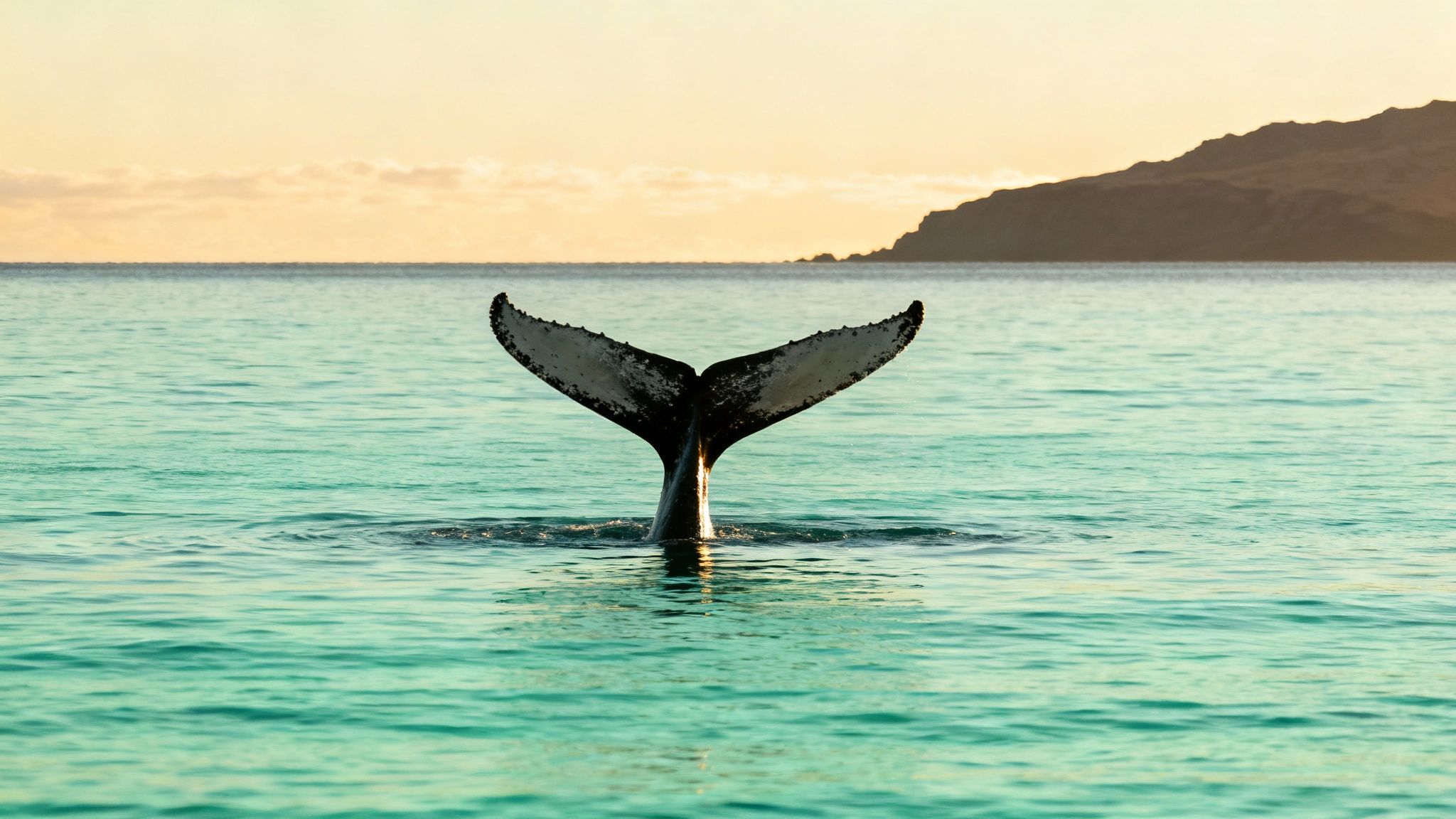
Why It's a Top Spot
The primary reason the Kohala Coast stands out is the sheer density of whale activity. The shallow, protected waters create a safe haven, meaning you are more likely to see a variety of behaviors, from tender moments between a mother and her calf to the spectacular breaches of competing males. Its accessibility makes it suitable for all types of whale watchers, from families with young children on a resort beach to avid photographers on a dedicated boat tour.
The protected coves and calm seas along the Kohala Coast offer unparalleled opportunities for observing natural humpback whale behavior. The concentration of mothers and calves here is particularly high, providing a unique glimpse into the early life of these magnificent creatures.
Prime Viewing Locations from Shore
You don't need a boat to have an incredible whale watching experience here. Several spots offer fantastic, free, and accessible shore-based viewing:
- Puako Bay: The rocky shoreline and clear water here provide an elevated vantage point. It's an excellent spot for spotting spouts, tail slaps, and even full breaches offshore.
- Hapuna Beach: Known for its expansive white sand, this beach also offers wide, unobstructed ocean views. Find a comfortable spot on the sand and scan the horizon for activity.
- Anaehoomalu Bay (A-Bay): A popular beach with calm waters, A-Bay is another great location. The gentle slope of the bay often brings whales surprisingly close to shore.
- Kawaihae Harbor: While a primary departure point for boat tours, the harbor walls and surrounding areas can also be good spots for watching whales entering and leaving the bay.
Actionable Tips for Kohala Coast Whale Watching
To maximize your experience, keep these practical considerations in mind:
- Go Early: The morning hours typically offer the calmest water conditions and best light, making it easier to spot whale activity.
- Bring Gear: For shore-based viewing, a good pair of binoculars or a spotting scope is essential to get a closer look at the action.
- Know What to Look For: Scan the horizon for the "blow," a misty spout of water that can rise up to 15 feet in the air. Also, watch for pectoral fin slaps, tail lobs, and the ultimate prize, the breach.
- Be Patient: Whales are on their own schedule. They typically surface to breathe every 5-15 minutes when resting, so find a comfortable spot and give yourself time.
- Book Tours in Advance: If opting for a boat tour departing from this coast, book well ahead, especially during the peak months of February and March.
2. Captain Dan McSweeney's Whale Watch Learning Adventures
For those seeking an experience that goes beyond a standard tour, Captain Dan McSweeney's Whale Watch Learning Adventures offers an unparalleled educational journey into the world of Hawaii's cetaceans. This isn't just a tour; it's a research-based expedition led by a renowned marine mammal researcher with over 35 years of experience studying the Big Island's whale and dolphin populations. The focus here is on deep learning, conservation, and year-round whale watching, making it a unique option for whale watching on the Big Island.
Unlike many operations that focus solely on the seasonal humpback migration, Captain Dan's tours operate throughout the year, targeting the Big Island's diverse resident cetacean species. This provides a rare opportunity to encounter pilot whales, false killer whales, sperm whales, and numerous dolphin species in their natural habitat. During the winter months, the focus shifts to include the visiting humpbacks, but the educational and research-driven approach remains constant, offering a richer, more profound understanding of the marine life you are observing.
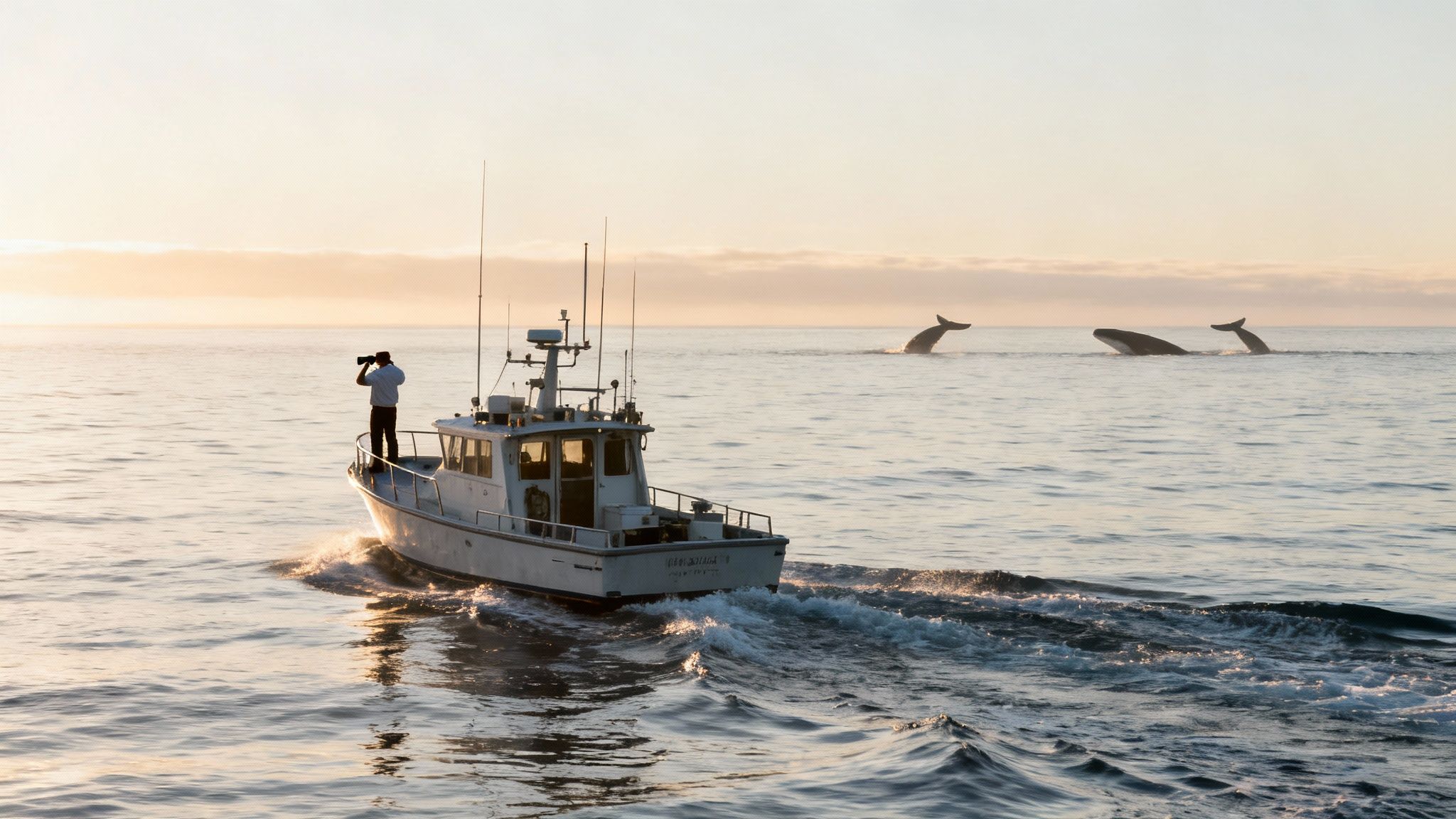
Why It's a Top Spot
This experience is distinguished by its scientific foundation. Captain Dan McSweeney is not just a guide; he is an active researcher whose work has been featured in documentaries and published in scientific journals. Passengers benefit directly from this expertise, gaining insights into complex behaviors, social structures, and the conservation status of these animals. It's a fantastic choice for marine biology enthusiasts, curious families, and anyone who wants their tourism dollars to support meaningful research and conservation.
This tour provides a unique, year-round window into the lives of the Big Island's resident whales, not just the seasonal humpbacks. It's a floating classroom where every sighting contributes to decades of ongoing scientific research.
Prime Viewing Opportunities and Experiences
The unique nature of these tours means every trip is different, with encounters dictated by the whales themselves. Here's what you might experience:
- Year-Round Residents: Witness large pods of pilot whales, sometimes numbering over 50 individuals, or observe the fascinating hunting techniques of the endangered false killer whale.
- Rare Species: The tour offers the chance to see less common species like melon-headed whales, pygmy killer whales, and even the deep-diving sperm whale.
- Humpback Season: During winter, the focus includes observing the full spectrum of humpback behaviors, from competitive pods of males to tender moments between mothers and calves.
- Direct Contribution to Research: Your presence on the boat helps fund and facilitate ongoing data collection that is crucial for the protection of Hawaii's marine mammals.
Actionable Tips for This Learning Adventure
To get the most out of this specialized tour, consider the following advice:
- Book Well in Advance: With a small group size and high demand, especially during humpback season (January-March), it's essential to book your trip 2-3 months ahead.
- Prepare for Open Ocean: The boat travels offshore where waters can be choppier. If you are prone to motion sickness, take medication beforehand as a precaution.
- Come Ready to Learn: Bring a notebook and pen. Captain Dan shares a wealth of information, and you'll want to remember the fascinating details. Don't be shy about asking questions.
- Pack Accordingly: Dress in layers, as conditions can be cooler and windier offshore. A quality camera with a good zoom lens is highly recommended for capturing images of distant wildlife.
- Explore Other Tours: If you're interested in different types of marine excursions, you can learn more about other whale watching tours in Kona, Hawaii to compare options.
3. Puukohola Heiau National Historic Site – Free Shore Viewing
For those seeking an exceptional and free whale watching Big Island experience from shore, the Puukohola Heiau National Historic Site is an unparalleled destination. Located near Kawaihae Harbor on the northwestern coast, this sacred site offers a unique blend of profound cultural history and prime marine life viewing. The elevated position of the heiau (an ancient Hawaiian temple) provides a commanding, panoramic vantage point over the waters of the Hawaiian Islands Humpback Whale National Marine Sanctuary.
These very waters have been significant for centuries, not just for the migrating whales, but also for the Hawaiian people. The name Puukohola literally translates to "Hill of the Whale," suggesting a long-standing connection between this sacred place and the majestic creatures that frequent its shores. Visiting the site allows you to stand where ancient Hawaiians once stood, watching the same timeless migration patterns unfold against a backdrop of deep historical importance.
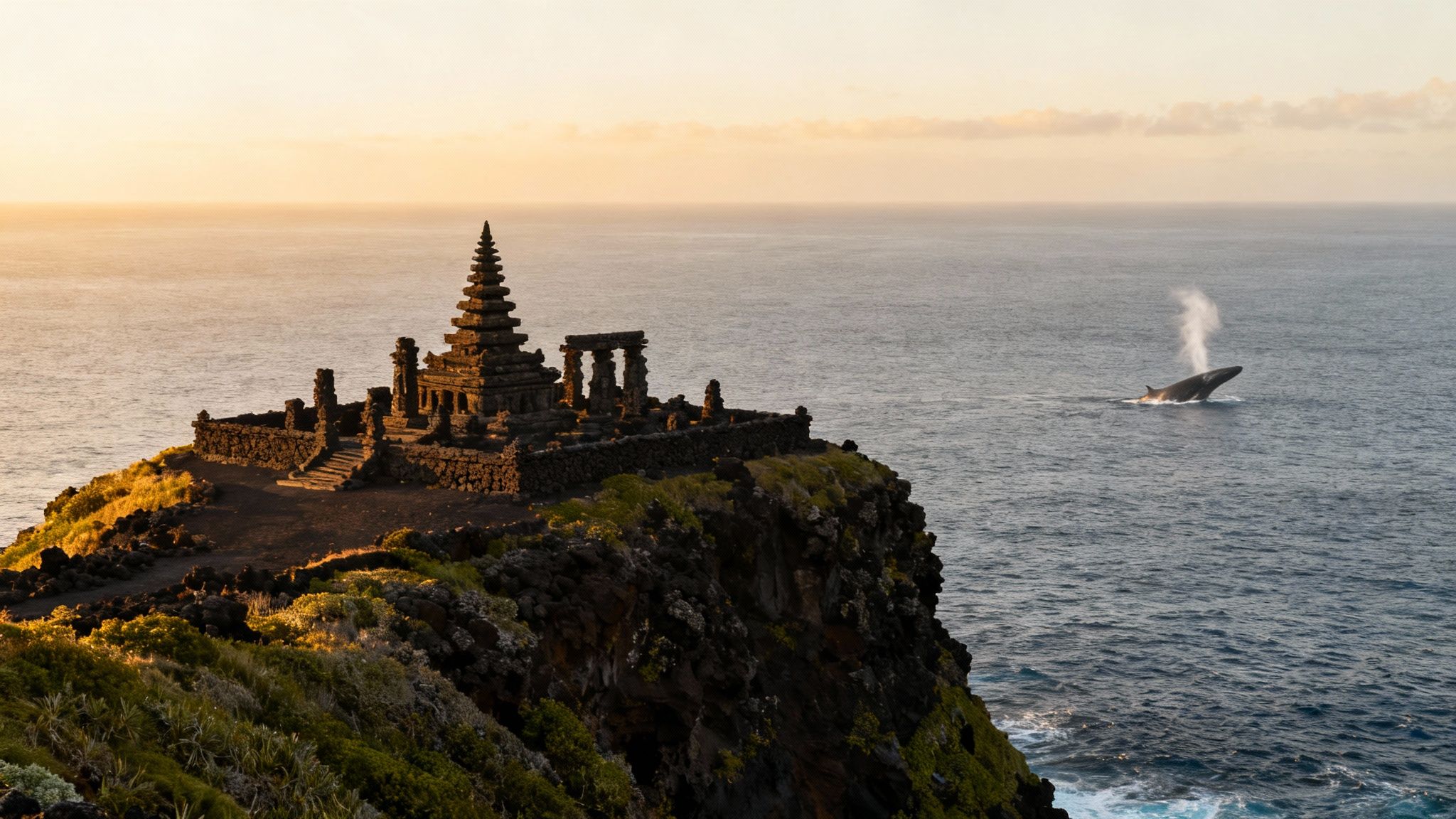
Why It's a Top Spot
Puukohola Heiau offers a powerful, multi-layered experience. It is one of the most reliable spots for shore-based whale watching due to its elevated, unobstructed coastal views. The combination of cultural immersion and natural spectacle makes it a truly memorable outing. During the peak season, it’s not uncommon to spot numerous whale pods from the park's viewing areas, making it a favorite for photographers, families, and history enthusiasts alike. Park rangers often provide educational programs, enhancing the experience with expert insights.
The natural amphitheater created by the coastline here channels whale activity close to shore. Watching a humpback breach from the grounds of a temple built by King Kamehameha I is a profound experience that connects you to both nature and Hawaiian history.
Prime Viewing Locations from the Site
The National Historic Site is designed to facilitate excellent viewing while respecting the sacred grounds of the heiau itself. The primary viewing areas are accessible and well-maintained:
- Park Visitor Center: The area around the visitor center provides a fantastic, elevated lookout point. Rangers are often available here to answer questions and point out recent sightings.
- Coastal Trail: A short, accessible trail leads from the visitor center down towards the coast, offering different perspectives and angles for spotting whales.
- Overlook Points: Designated overlooks along the trail are perfectly positioned for scanning the horizon and the bay below.
Actionable Tips for Puukohola Heiau Whale Watching
To make the most of your visit to this historic and naturally rich site, consider these tips:
- Visit in the Morning: Early morning hours typically offer the calmest seas and reduced glare, making it much easier to spot a whale's "blow" or a distant splash.
- Bring Binoculars: While whales can be seen with the naked eye, a good pair of binoculars is essential for getting a closer look at behaviors like fin slapping and spy-hopping. The ranger station may have loaner pairs available.
- Attend Ranger Programs: Check the National Park Service website for the schedule of ranger-led talks and events, especially during February's Humpback Whale Awareness Month.
- Scan Systematically: Instead of randomly looking, pick a spot on the horizon and scan slowly from left to right. Look for the tell-tale misty spout of a whale's breath. You can get more helpful hints in our guide to the whale season on the Big Island.
- Combine Your Trip: The site is located right next to Spencer Beach Park, a beautiful white-sand beach perfect for swimming and picnicking after a morning of whale watching.
4. Fair Wind Cruises – Luxury Catamaran Whale Watching
For those seeking a premium and highly comfortable whale watching on the Big Island experience, Fair Wind Cruises offers an exceptional option. Operating since 1971, they run a fleet of large, stable catamarans like the Fair Wind II and Hula Kai, designed for smooth sailing along the Kona Coast. These vessels provide a luxurious platform with spacious decks, ample shade, and onboard amenities, making the journey as enjoyable as the sightings themselves.
Fair Wind's tours are known for blending recreation with education, ensuring passengers leave with a deeper appreciation for the marine environment. During the peak season from December to April, they offer dedicated whale watching excursions. Many of their popular snorkel tours, such as those to Kealakekua Bay, also incorporate whale watching, providing a comprehensive marine adventure.
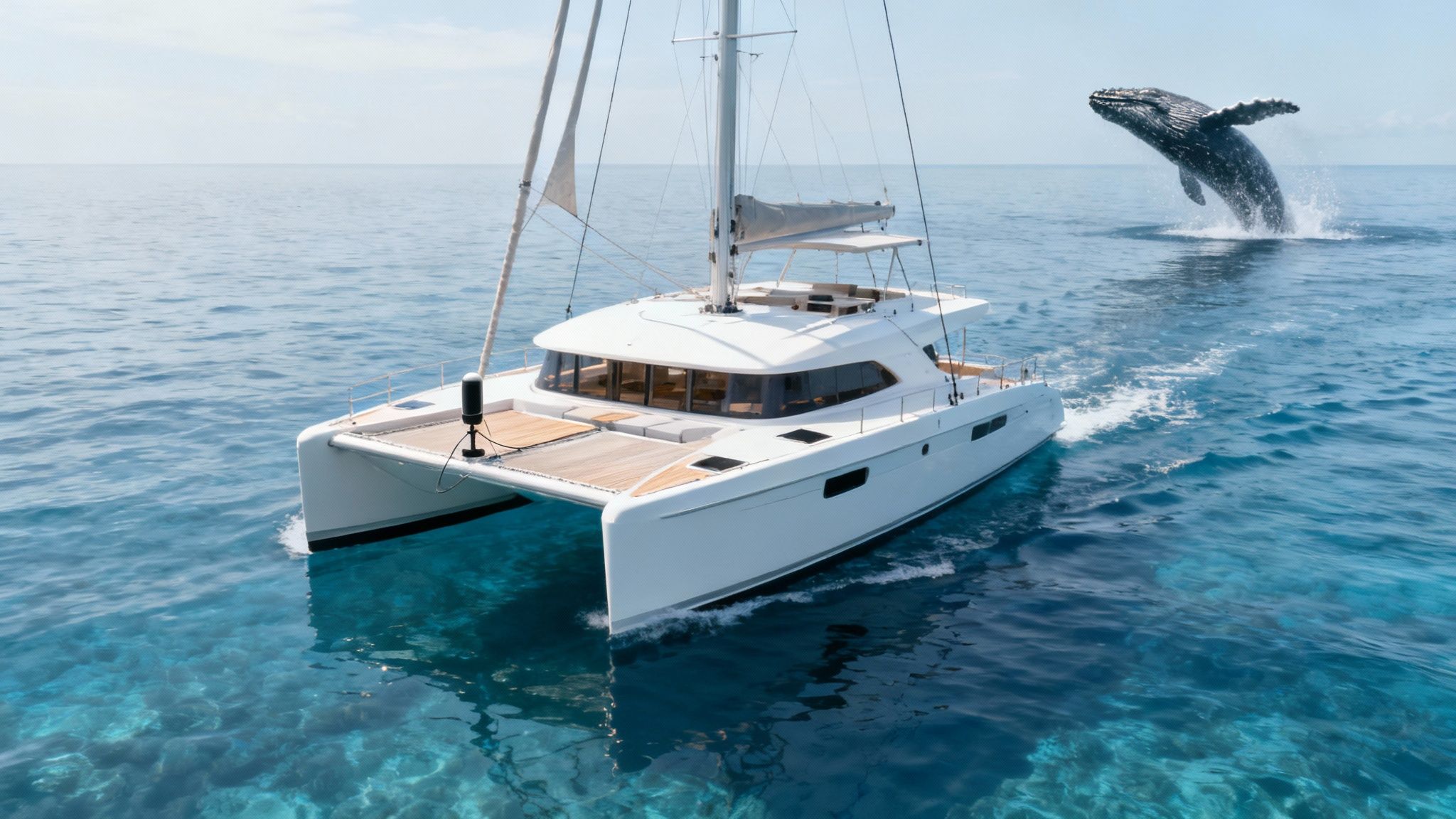
Why It's a Top Spot
Fair Wind stands out for its combination of comfort, stability, and educational value. The large catamarans are ideal for families, first-time boaters, or anyone prone to seasickness, as they minimize the rock and sway of the ocean. Their experienced crew excels at locating whale pods and providing insightful commentary on their behaviors. A unique feature is the use of hydrophones, allowing passengers to listen to the hauntingly beautiful songs of the humpback whales beneath the waves.
The stability and amenities of Fair Wind's catamarans provide an accessible and luxurious way to experience the Kona Coast's vibrant whale activity. The inclusion of educational elements and hydrophones for listening to whale songs creates a truly immersive and memorable outing.
Prime Viewing Opportunities and Experiences
Departing from Keauhou Bay, Fair Wind's tours explore the rich waters of the Kona Coast, which are frequented by a variety of whale groups. Passengers often witness incredible displays:
- Competitive Pods: It's common to encounter energetic "competition pods" where multiple males vie for the attention of a single female, resulting in dramatic surface behaviors.
- Mother and Calf Pairs: The sheltered coves along the coast are perfect nurseries, offering serene opportunities to watch mothers teach and protect their newborn calves.
- Breaching and Surface Activity: The spacious decks offer 360-degree views, perfect for capturing breathtaking photos of whales breaching, slapping their tails (lobs), and pectoral fins.
- Combined Adventures: Booking a snorkel tour to Kealakekua Bay during whale season means you get to experience the pristine reef and a whale watching tour in one trip.
Actionable Tips for Fair Wind Cruises
To get the most out of your luxury catamaran tour, follow these expert recommendations:
- Book a Morning Tour: The ocean is typically calmest in the morning, which enhances the stability of the catamaran and makes spotting whales easier.
- Arrive Early: Get to the check-in at least 30 minutes before departure to secure the best seats and get settled without rushing. The bow is a popular spot for unobstructed views.
- Listen to the Whales: Don't miss the opportunity when the crew lowers the hydrophone. Hearing the complex songs travel through the water is a truly unique experience.
- Bring a Light Jacket: Even on a sunny day, the breeze on the water can create a wind chill, so a light layer is always a good idea.
- Ask the Crew: The naturalists and crew are a wealth of knowledge. Ask them about whale behavior or the best spots on the boat for photography. Learn more about the amazing whale watching Big Island opportunities.
5. Hilo Side Whale Watching – Laupahoehoe Point and Kolekole Beach Park
While the calm Kona side gets most of the attention, the eastern Hilo side of the island offers a completely different, yet rewarding, whale watching on the Big Island experience. This rugged windward coast, known for its dramatic cliffs and lush landscapes, provides a wilder backdrop for spotting humpback whales. Visitors willing to explore this area are often rewarded with uncrowded viewpoints and a raw, authentic connection to nature.
The ocean conditions here are generally rougher than along the Kohala Coast, meaning whales are often seen farther from shore. However, the elevated vantage points along the Hamakua Coast offer panoramic ocean vistas perfect for scanning the horizon. This side appeals to adventurous travelers seeking solitude and stunning scenery away from the main tourist hubs, providing a chance to see whales in a more untamed environment.
Why It's a Top Spot
The Hilo side stands out for its dramatic scenery and lack of crowds. Whale watching here is less about getting on a boat and more about a patient, land-based treasure hunt. The experience is integrated into exploring the stunning Hamakua Heritage Corridor, with its waterfalls, sea cliffs, and verdant valleys. It’s an ideal choice for those who appreciate epic landscapes and the thrill of spotting wildlife from a clifftop perch.
The raw, powerful beauty of the Hilo coast provides a unique and humbling setting for whale watching. Seeing a humpback breach against a backdrop of black lava cliffs and crashing surf is an unforgettable, wild Hawaiian experience.
Prime Viewing Locations from Shore
The Hamakua Coast is dotted with scenic overlooks and parks perfect for shore-based whale watching. Patience and a good pair of binoculars are key to success:
- Laupahoehoe Point Beach Park: This scenic peninsula juts out into the ocean, offering incredible 180-degree views. The elevation provides a fantastic platform for spotting spouts and breaches far offshore.
- Kolekole Beach Park: Nestled under a high bridge at the mouth of a stream, this park offers a unique coastal view framed by a nearby waterfall. It's a serene spot to scan the water for activity.
- Four Mile Scenic Drive: This short, beautiful drive just north of Hilo features several pullouts and overlooks. Each one offers a different angle of the coastline, increasing your chances of a sighting.
- Hilo Bay Breakwater: For a more urban option, the long breakwater protecting Hilo Bay can be a good spot. Local fishermen often have the latest news on whale movements in the area.
Actionable Tips for Hilo Side Whale Watching
To make the most of your Hilo-side adventure, a different approach is needed compared to the calm Kona waters:
- Visit in the Morning: Mornings often have clearer skies before the typical afternoon clouds and rain showers move in along the windward coast.
- Binoculars are a Must: The whales here are frequently much farther out at sea. High-quality, powerful binoculars are absolutely essential for a good viewing experience.
- Prioritize Safety: The surf is powerful and the cliffs are steep. Always stay a safe distance from edges and be aware of wave conditions, especially at spots like Laupahoehoe Point.
- Check the Weather: A clear, sunny day will significantly improve your visibility and chances of spotting whales. Overcast or rainy conditions can make it nearly impossible.
- Be Prepared for the Elements: The Hilo side is wetter and often cooler. Pack rain gear and an extra layer of clothing, as the weather can change in an instant.
6. Ocean Sports Whale Watching – Waikoloa Beach Resort
Operating directly from the pristine shores of Anaehoomalu Bay within the Waikoloa Beach Resort, Ocean Sports offers an exhilarating and convenient option for whale watching on the Big Island. Established in 1983, they are a long-standing operator on the Kohala Coast, known for their professional crew and exciting, action-oriented tours. Their fleet often includes rigid-hull inflatable boats (RHIBs) and high-speed rafts designed for swift, stable travel to wherever the whale activity is happening.
The primary advantage of Ocean Sports is their location and tour style. Departing from the calm, protected waters of the Kohala Coast, they are already in a prime humpback whale nursery. Their nimble vessels allow them to respond quickly to sightings, increasing the chances of up-close encounters with dynamic behaviors like breaching and competitive pod interactions. This makes their tours particularly appealing to adventure seekers and wildlife photography enthusiasts.
Why It's a Top Spot
Ocean Sports stands out for its blend of high-energy adventure and marine education. Their knowledgeable crew, often trained in marine biology, provides fascinating insights into whale behavior. The use of underwater hydrophones to listen to the hauntingly beautiful whale songs adds a unique sensory dimension to the experience. Their ability to maneuver quickly means less time traveling and more time actively observing whales.
Ocean Sports provides a dynamic, up-close whale watching adventure right from the Waikoloa resort area. Their fast-moving rafts are perfect for covering more ground and getting to the heart of the action, whether it's a breaching adult or a tender moment between mother and calf.
Signature Experiences
Ocean Sports tours are known for creating memorable moments on the water. Passengers frequently report incredible sightings and engaging encounters:
- Competitive Pods: Witnessing the power of male humpbacks competing for a mate is a common highlight, with thrilling displays of pectoral fin slaps and tail lobs.
- Mother-Calf Pairs: The calm resort coastline waters are an ideal nursery, offering gentle and intimate views of mothers teaching their calves essential survival skills.
- Whale Song Sessions: The crew often drops a hydrophone into the water, allowing guests to hear the complex and melodic songs of male humpbacks in real time.
- Combination Tours: During whale season, even their snorkeling trips often become hybrid adventures, with exciting whale sightings on the way to and from the reef.
Actionable Tips for Ocean Sports Tours
To make the most of your adventure with Ocean Sports, a little preparation goes a long way:
- Book an Early Tour: The morning trips generally experience the calmest ocean conditions and less wind, providing a smoother ride and better viewing.
- Protect Your Gear: The high-speed ride can create sea spray. Use a waterproof bag or housing for cameras and phones to keep them safe and dry.
- Dress Appropriately: Wear quick-drying clothing or a light waterproof jacket. A secure hat and sunglasses with a retaining strap are highly recommended.
- Prevent Seasickness: If you are prone to motion sickness, take medication at least 30 minutes before departure to ensure it's effective.
- Sit for Stability: For the smoothest ride on a RHIB or raft, try to find a seat toward the middle of the boat.
- Engage with the Crew: Don't hesitate to ask questions. The crew members are passionate and full of knowledge about whale behavior and the local marine ecosystem.
Whale Watching Options Comparison Guide
| Experience | Core Features & Highlights | User Rating & Quality | Unique Selling Points | Target Audience | Price & Value |
|---|---|---|---|---|---|
| Kohala Coast – Prime Humpback Whale Habitat | Peak whale season Jan-Mar, calm protected waters | ★★★★☆ | High mother-calf concentrations, shore & boat views ✨ | 👥 Families, resort visitors | 💰 Moderate, some fees for resorts |
| Captain Dan McSweeney's Whale Watch Learning | Year-round, research-driven, small groups (max 6) | ★★★★★ 🏆 | Deep education, rare species sightings ✨ | 👥 Whale enthusiasts, learners | 💰 Higher price, premium experience |
| Puukohola Heiau National Historic Site | Free shore viewing, cultural & educational talks | ★★★★☆ | Free access, cultural context ✨ | 👥 Families, budget travelers | 💰 Free |
| Fair Wind Cruises – Luxury Catamaran | Large catamarans, 360° views, hydrophone | ★★★★★ 🏆 | Stable boat, onboard naturalists, snacks ✨ | 👥 Families, comfort seekers | 💰 Higher price, premium amenities |
| Hilo Side Whale Watching | Uncrowded, scenic volcanic coast, free access | ★★★☆☆ | Solitude, authentic local vibe ✨ | 👥 Independent travelers, adventurers | 💰 Free, no tours |
| Ocean Sports Whale Watching | Fast RHIB boats, guaranteed sightings | ★★★★☆ | Agile boats, active encounters, photo ops ✨ | 👥 Adventure seekers, snorkelers | 💰 Moderate to high |
Final Thoughts: Making Your Big Island Whale Encounter Unforgettable
Your journey to witness the majestic humpback whales off the Big Island's shores is more than just a tour; it's a profound connection with nature's grandeur. We've navigated through the calm, protected waters of the Kohala Coast, explored the educational voyages with pioneers like Captain Dan McSweeney, and discovered the serene beauty of land-based viewing from Puukohola Heiau. From the luxurious comfort of Fair Wind Cruises' catamarans to the rugged, less-traveled shores of the Hilo side, the options for whale watching big island are as diverse and spectacular as the island itself. The key to transforming a good trip into an unforgettable one lies in thoughtful preparation and a mindset of respect and awe.
Key Takeaways for Your Adventure
As you finalize your plans, keep these essential insights at the forefront. They represent the collective wisdom of seasoned guides and lifelong ocean enthusiasts, designed to maximize your experience while minimizing your impact.
- Timing is Everything: While the whale season spans from December to April, the peak months of January, February, and March offer the highest concentration of humpbacks. Booking your tours during this window dramatically increases your chances of witnessing spectacular behaviors like breaching, tail slapping, and pectoral fin waves.
- Location Matters: The leeward Kohala Coast is the undisputed epicenter of whale activity due to its calm, warm, and protected waters, which are ideal for mothers and calves. While Hilo offers unique viewing opportunities, first-time visitors or those with limited time should prioritize the Kona and Kohala coasts for the most reliable sightings.
- Choose Your Operator Wisely: Your experience is shaped by the crew leading it. Opt for companies with a strong commitment to conservation and education. Look for those who adhere strictly to federal guidelines, maintain a respectful distance, and employ naturalists who can provide deep insights into whale behavior and the marine ecosystem. Small group tours, like those offered by many local operators, often provide a more intimate and personal encounter.
Turning Plans into Lifelong Memories
With the knowledge from this guide, you are now equipped to make informed decisions for your whale watching adventure. The next step is to take action. Begin by assessing your group's priorities. Are you seeking a deeply educational, almost scientific experience? Or is a comfortable, family-friendly cruise with amenities more your style? Perhaps the quiet solitude of watching from a coastal bluff is the perfect fit.
Once you’ve defined your ideal experience, book your chosen tour well in advance, especially for travel during the peak season. Tours fill up quickly, and last-minute bookings can be difficult to secure. As your departure date approaches, prepare for the day itself. Pack a small day bag with essentials. Remember that even on a warm Hawaiian day, the ocean breeze can be cool, so a light jacket or windbreaker is always a good idea. Polarized sunglasses are crucial for cutting through the sun's glare on the water, making it much easier to spot a distant spout or breach.
To keep your energy up and enhance your comfort during your whale watching adventure, consider bringing along some provisions. You can find excellent ideas for healthy snacks for your whale watching trip that are easy to pack and perfect for a day on the water. Finally, and most importantly, bring a spirit of patience and wonder. These are wild animals in their natural habitat, and every encounter is unique and unpredictable. The ocean operates on its own schedule, and the most rewarding moments often come when you least expect them. Embracing the journey and the anticipation is part of the magic of whale watching big island. This experience is a powerful reminder of our connection to the ocean and the importance of preserving these magnificent creatures for generations to come.
While our primary focus is guiding you through the incredible underwater worlds of Kealakekua Bay and the Kona coast's famous manta ray snorkel, our passion extends to all marine life that graces our island's waters. The annual return of the humpback whales is a season of celebration for us, and we encourage you to experience it fully. When you're ready to explore what lies just beneath the waves, let Kona Snorkel Trips provide you with another unforgettable Big Island adventure.
